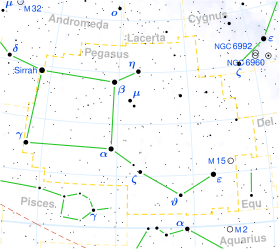Pi1 Pegasi
 | |
| Observation data Epoch J2000.0 Equinox J2000.0 | |
|---|---|
| Constellation | Pegasus |
| Right ascension | 22h 09m 13.633s[1] |
| Declination | +33° 10′ 20.41″[1] |
| Apparent magnitude (V) | +5.595[2] |
| Characteristics | |
| Spectral type | G6 III |
| Astrometry | |
| Radial velocity (Rv) | +8.50±0.1 km/s |
| Proper motion (μ) | RA: −61.14±0.32[1] mas/yr Dec.: −66.84±0.32[1] mas/yr |
| Parallax (π) | 11.30 ± 0.30[1] mas |
| Distance | 289 ± 8 ly (88 ± 2 pc) |
| Absolute magnitude (MV) | 0.84[3] |
| Details | |
| Mass | 1.92[3] M☉ |
| Radius | 9[4] R☉ |
| Luminosity | 201.6[3] L☉ |
| Surface gravity (log g) | 2.7[4] cgs |
| Temperature | 4793[3] K |
| Metallicity [Fe/H] | -0.22[3] dex |
| Rotational velocity (v sin i) | 4.0[4] km/s |
| Other designations | |
| Database references | |
| SIMBAD | data |
Pi1 Pegasi (π1 Pegasi) is a star in the constellation Pegasus. Of apparent magnitude 5.59, its brightness is dimmer by 0.05 magnitude due to interstellar extinction. It is a yellow giant 1.92 times as massive as the Sun and 201.6 times as luminous.[3] Based upon changes to the proper motion of the visible component, this is a probable astrometric binary.[5]
References
- 1 2 3 4 5 van Leeuwen, F. (November 2007), "Validation of the new Hipparcos reduction", Astronomy and Astrophysics, 474 (2): 653–664, arXiv:0708.1752, Bibcode:2007A&A...474..653V, doi:10.1051/0004-6361:20078357
- 1 2 SIMBAD, Pi1 Pegasi (accessed 16 March 2016)
- 1 2 3 4 5 6 Takeda, Yoichi; Sato, Bun'ei; Murata, Daisuke (August 2008), "Stellar Parameters and Elemental Abundances of Late-G Giants", Publications of the Astronomical Society of Japan, 60 (4): 781–802, arXiv:0805.2434, Bibcode:2008PASJ...60..781T, doi:10.1093/pasj/60.4.781
- 1 2 3 Massarotti, Alessandro; et al. (January 2008), "Rotational and radial velocities for a sample of 761 HIPPARCOS giants and the role of binarity", The Astronomical Journal, 135 (1): 209–231, Bibcode:2008AJ....135..209M, doi:10.1088/0004-6256/135/1/209.
- ↑ Eggleton, P. P.; Tokovinin, A. A. (September 2008), "A catalogue of multiplicity among bright stellar systems", Monthly Notices of the Royal Astronomical Society, 389 (2): 869–879, arXiv:0806.2878, Bibcode:2008MNRAS.389..869E, doi:10.1111/j.1365-2966.2008.13596.x.
This article is issued from
Wikipedia.
The text is licensed under Creative Commons - Attribution - Sharealike.
Additional terms may apply for the media files.